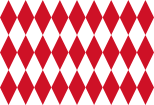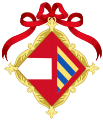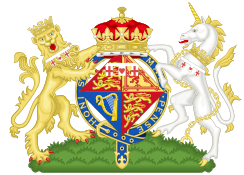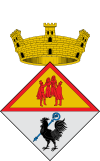Lozenge (heraldry)

The lozenge in heraldry is a diamond-shaped charge (an object that can be placed on the field of the shield), usually somewhat narrower than it is tall. It is to be distinguished in modern heraldry from the fusil, which is like the lozenge but narrower, though the distinction has not always been as fine and is not always observed even today. A mascle is a voided lozenge—that is, a lozenge with a lozenge-shaped hole in the middle—and the rarer rustre is a lozenge containing a circular hole in the centre. A field covered in a pattern of lozenges is described as lozengy; similar fields of mascles are masculy, and fusils, fusily (see Variation of the field). In civic heraldry, a lozenge sable is often used in coal-mining communities to represent a lump of coal.
A lozenge shaped escutcheon is used to depict heraldry for a female, but is also sometimes used as a shape for mural monuments in churches which commemorate females.[1] Funerary hatchments are generally shown within lozenge shaped frames, for both male and female deceased.
Lozengy


The blason Lozengy is a form of variation of the field or of another charge (for example a chevron lozengy) which consists of lozenges semée, or sown like seeds (Latin: semen, a seed), or strewn across the field, but in an organised contiguous pattern. The arms granted to the Canadian John Francis Cappucci bring an example of lozengy voided, the same as "lozengy" but with a smaller lozenge-shaped hole cut out of each segment.[2]
Examples
 This Monegasque flag is "lozengy argent and gules"
This Monegasque flag is "lozengy argent and gules".svg.png) A variant Flag of Bavaria, an array of 21 or more lozenges of blue and white
A variant Flag of Bavaria, an array of 21 or more lozenges of blue and white The personal arms of Margaret of Parma
The personal arms of Margaret of Parma The personal coat of arms of Anne, Princess Royal displayed on a lozenge.
The personal coat of arms of Anne, Princess Royal displayed on a lozenge. The personal coat of arms of Elena of Spain, Duchess of Lugo displayed on a lozenge.
The personal coat of arms of Elena of Spain, Duchess of Lugo displayed on a lozenge..svg.png) "Or, a lozenge sable"
"Or, a lozenge sable" Mascles
Mascles.svg.png) Fusils
Fusils.svg.png) A rustre
A rustre A lozengy shield
A lozengy shield Arms of Borredà, a municipality in Catalonia
Arms of Borredà, a municipality in Catalonia
References
- ↑ For example the lozenge shaped monument to Arabella Morgan (1741-1828) in St Andrew's Church, High Ham, Somerset, see image File:St Andrew's Church, High Ham2.jpg
- ↑ "Public Register of Arms, Flags and Badges".
Further reading
- Fox-Davies, Arthur Charles (1909). A Complete Guide to Heraldry. New York: Dodge Pub. Co.(and the more recent editions) LCCN 09-23803
- Canadian Heraldic Authority, Public Register, with many useful official versions of modern coats of arms, searchable online archive.gg.ca
- South African Bureau of Heraldry, data on registered heraldic representations (part of National Archives of South Africa); searchable online (but no illustration), national.archsrch.gov.za
- Civic Heraldry of England and Wales, fully searchable with illustrations, civicheraldry.co.uk
- Heraldry Society of Scotland, members' arms, fully searchable with illustrations of bearings, heraldry-scotland.com
- Heraldry Society (England), members' arms, with illustrations of bearings, only accessible by armiger's name (though a Google site search would provide full searchability), theheraldrysociety.com
- Royal Heraldry Society of Canada, Members' Roll of Arms, with illustrations of bearings, only accessible by armiger's name (though a Google site search would provide full searchability), heralrdry.ca
- Brooke-Little, J P, Norroy and Ulster King of Arms, An heraldic alphabet (new and revisded edition), Robson Books, London, 1985 (first edition 1975); very few illustrations
- Greaves, Kevin, A Canadian Heraldic Primer, Heraldry Society of Canada, Ottawa, 2000, lots but not enough illustrations
- Moncreiffe of Easter Moncreiffe, Iain, Kintyre Pursuivant of Arms, and Pottinger, Don, Herald Painter Extraordinary to the Court of the Lord Lyon King of Arms Simple Heraldry, Thomas Nelson and Sons, London andf Edinburgh, 1953; splendidly illustrated
- Friar, Stephen (ed) A New Dictionary of Heraldry Alphabooks, Sherborne, 1987; with very few illustration of attitudes
